Saint Therese of the Child Jesus
of the Holy Face
Entries in foundation of the Lisieux Carmel (1)
St. Therese of Lisieux and the influenza pandemic of 1892, part 4: the life and death of the first postulant, Sister Saint-Joseph of Jesus
Sister Saint-Joseph of Jesus (1809-1892),
the first postulant of the Lisieux Carmel
Sister Saint-Joseph of Jesus, the first victim of the influenza, was the oldest nun living in the Lisieux Carmel and had been its first postulant. When Therese entered in 1888, Sister Saint-Joseph and Mother Genevieve were the only two nuns there who had participated in the founding of the Lisieux Carmel in 1838.
Eugenie Lerebourg: her childhood
As we know little about Sister Saint-Joseph’s life in Carmel, I will go into some detail about her early life and her part in the foundation.[1] She was not a native of Normandy. She had been born Marie-Eugenie Lerebourg, in the commune of Saint-Meen-le-Grand in the Ille-et-Vilaine department of Brittany
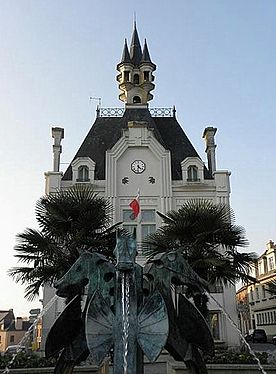 Saint-Meen-le-Grand Town Hall
Saint-Meen-le-Grand Town Hall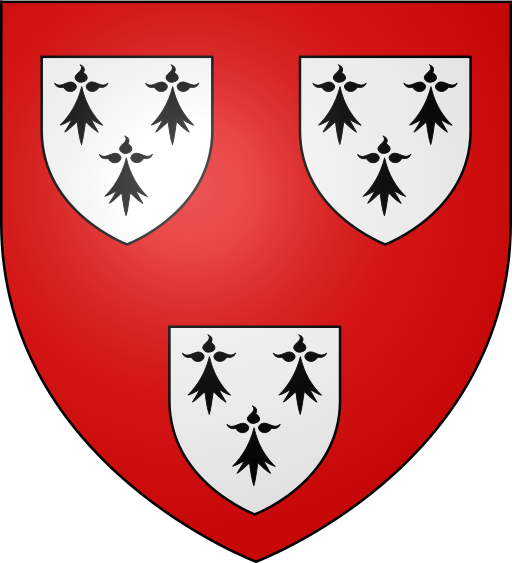 Coat of arms of Saint-Meen-le-GranHer father, Charles, was an officer in the Imperial Army.[2] Her brother Francois, no more than two years old, died a few hours after Eugenie was born. He was buried on the day of her baptism. Eugenie’s mother, Julienne Giclais, died in 1813, no more than 34 years old, when Eugenie was only four and a half. The frequent deaths of the mothers of young children in that era left the widowers unable to care for the children and earn a living for the family, so the personal care of the children became precarious. Since her father, a policeman,[3] could not look after two children, he entrusted Eugenie to the town schoolteacher, from whom, according to the Carmel, she “received more blows than caresses.”[4] Charles was dismissed from the army in 1816 and died a few years later, leaving Eugenie an orphan. Her older brother, now living in Brittany, invited Eugenie to stay with him.
Coat of arms of Saint-Meen-le-GranHer father, Charles, was an officer in the Imperial Army.[2] Her brother Francois, no more than two years old, died a few hours after Eugenie was born. He was buried on the day of her baptism. Eugenie’s mother, Julienne Giclais, died in 1813, no more than 34 years old, when Eugenie was only four and a half. The frequent deaths of the mothers of young children in that era left the widowers unable to care for the children and earn a living for the family, so the personal care of the children became precarious. Since her father, a policeman,[3] could not look after two children, he entrusted Eugenie to the town schoolteacher, from whom, according to the Carmel, she “received more blows than caresses.”[4] Charles was dismissed from the army in 1816 and died a few years later, leaving Eugenie an orphan. Her older brother, now living in Brittany, invited Eugenie to stay with him.
Eugenie’s young womanhood
At that time good priests often interested themselves in the many orphans around them and tried to secure their futures by arranging for them to receive care from the Church. About 1829 Fr. Olivier, a priest who exercised a ministry in the diocese of Bayeux, arranged for Eugenie, then about 20, to become a “lady boarder” with the nuns who administered the mental hospital of the Bon Sauveur in Caen.[5] 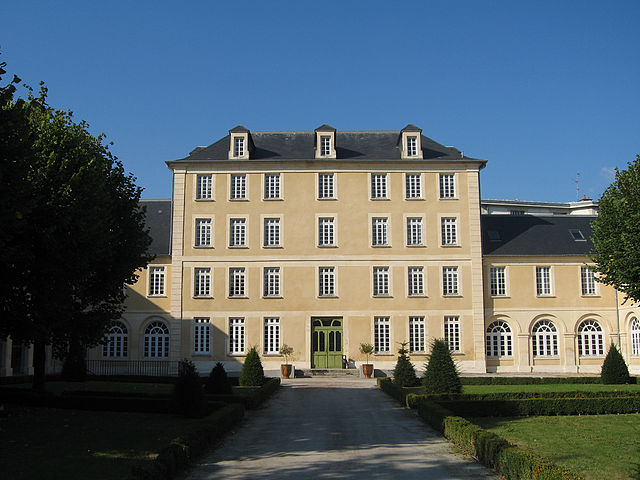 The Bon Sauveur Hospital in CaenIn this atmosphere, her heart expanded. She was inspired by generosity of the sisters, the Daughters of the Bon Sauveur (the “Good Savior”). Their congregation had been founded in 1720 in Caen by Anne LeRoy, who hoped to take up the work the Visitation of Caen[6] had been forced to leave.[7] Eugenie was accepted as a novice, but, a year later, showing signs of tuberculosis, she had to leave. She found a job as an assistant teacher in Caen and later in Lisieux.
The Bon Sauveur Hospital in CaenIn this atmosphere, her heart expanded. She was inspired by generosity of the sisters, the Daughters of the Bon Sauveur (the “Good Savior”). Their congregation had been founded in 1720 in Caen by Anne LeRoy, who hoped to take up the work the Visitation of Caen[6] had been forced to leave.[7] Eugenie was accepted as a novice, but, a year later, showing signs of tuberculosis, she had to leave. She found a job as an assistant teacher in Caen and later in Lisieux.
Eugenie encounters the project of a new Carmel
In Lisieux, about 1835, Eugenie met Fr. Pierre-Nicholas Sauvage, a curate at St. Jacques Church in Lisieux, who had been entrusted by his bishop with creating a new Carmelite foundation at Lisieux. 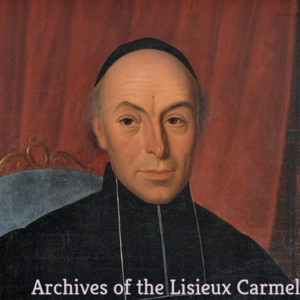 Fr. Pierre-Nicholas Sauvage, founding superior of the Lisieux CarmelHe recognized Eugenie’s vocation and spoke to her about the proposed new Carmel. The prospect of joining it filled her with happiness and hope. This foundation was the dream of two sisters, Athalie and Desiree Gosselin, of Le Havre, and Fr. Sauvage was to become its first “Superior.”[8] You may read the dramatic full story of the foundation and of the incredible obstacles Fr. Sauvage and the founders overcame at the Narrative of the Foundation of the Carmel of Lisieux by the hand of Mother Genevieve. (Much of the information below is drawn from that document). The stumbling blocks the founders faced, and the acute poverty in which they started, are a story worthy of St. Teresa of Avila.
Fr. Pierre-Nicholas Sauvage, founding superior of the Lisieux CarmelHe recognized Eugenie’s vocation and spoke to her about the proposed new Carmel. The prospect of joining it filled her with happiness and hope. This foundation was the dream of two sisters, Athalie and Desiree Gosselin, of Le Havre, and Fr. Sauvage was to become its first “Superior.”[8] You may read the dramatic full story of the foundation and of the incredible obstacles Fr. Sauvage and the founders overcame at the Narrative of the Foundation of the Carmel of Lisieux by the hand of Mother Genevieve. (Much of the information below is drawn from that document). The stumbling blocks the founders faced, and the acute poverty in which they started, are a story worthy of St. Teresa of Avila.
Finally the Carmel of Poitiers, where Sister Genevieve of St. Therese was then novice mistress, agreed to receive the postulants for the new foundation, and, once the young women had been trained at Poitiers, to lend two experienced nuns to help establish the foundation at Lisieux. The Gosselin sisters, who had pledged their fortune to endow the new house, and Caroline Gueret, another young woman from Lisieux, arrived at Poitiers and received the habit on April 26, 1837. 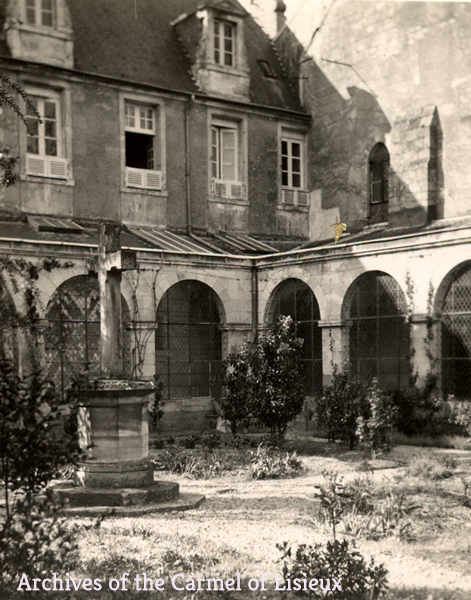 The Carmel of PoitiersEugenie preferred to finish out the year at the school where she was teaching at Lisieux. In July, she made a retreat at another Carmel, which confirmed her vocation so powerfully that she wanted to join her companions at Poitiers. Fr. Sauvage persuaded her to wait until the nuns arrived in Lisieux. She visited her brother and her extended family in Brittany to say good-by. In February 1838 she made a retreat at Notre Dame de la Delivrande (known in English as “Our Lady of Ransom”) and another retreat at the “Community of Charity.” She was in Lisieux to receive the group from Poitiers in March.
The Carmel of PoitiersEugenie preferred to finish out the year at the school where she was teaching at Lisieux. In July, she made a retreat at another Carmel, which confirmed her vocation so powerfully that she wanted to join her companions at Poitiers. Fr. Sauvage persuaded her to wait until the nuns arrived in Lisieux. She visited her brother and her extended family in Brittany to say good-by. In February 1838 she made a retreat at Notre Dame de la Delivrande (known in English as “Our Lady of Ransom”) and another retreat at the “Community of Charity.” She was in Lisieux to receive the group from Poitiers in March.
Fr. Sauvage had first hoped to buy a property for the Carmelites in the “Nouveau Monde” (the "New World") neighborhood on the heights outside the city, where Les Buissonnets, the villa Louis Martin leased for his family in 1877, would stand. After many frustrations, he had no choice but to settle for a modest house and garden in town, on rue de Livarot (today called rue Carmel) in the valley of the Orbiquet River. The spot is low, marshy, and unhealthy. It was a small house standing on that part of the property where later the extern sisters lived (to the right of the present-day entrance to the public chapel). The building of the monastery, completed later under the direction of Mother Marie de Gonzague, Therese’s first prioress, would take 40 years.
Eugenie receives the founders at Lisieux
While the construction necessary to turn the house into a monastery was being done, the Carmelites had been offered shelter by a widow, Mme. Le Boucher, whom Father Sauvage had interested in the foundation. Eugenie Lerecourt helped to prepare their quarters in Mme Le Boucher’s house on the rue Beuvilliers. The Poitiers community sent Mother Elisabeth of Saint-Louis, 62, as prioress and Sister Genevieve of St. Teresa, 32, as sub-prioress and novice mistress. 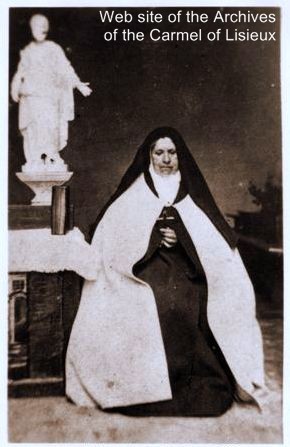 Mother Genevieve about 1860The three novices who had been formed at Poitiers but were to be professed at Lisieux were the Gosselin sisters (Athalie, 30, named Sister Teresa of St. Joseph; Desiree, 26, Sister Marie of the Cross); and Caroline Gueret, now 21, Sister St. John of the Cross. Fr. Sauvage escorted the little group from Poitiers, and, after an adventurous, uncomfortable journey, they reached Lisieux in the pouring rain at four o’clock in the morning on March 15, 1838. Eugenie was waiting for them at the station hotel with Mme. LeBoucher. To Fr. Sauvage’s distress, his arrangements for a carriage to transport the nuns and their baggage to their temporary quarters had fallen through, and Eugenie could supply only a cart with a tarpaulin nailed over it. The cart would not hold the baggage, so Eugenie, trembling with anxiety, was forced to wait alone at the hotel to guard their luggage until the cart could return for a second trip. Meanwhile the other nuns huddled under the tarpaulin for the bumpy ride to their new home. Mother Elisabeth sat on a chair, frightened that she would be thrown to the right, to the left, or on the ground. Laughing and crying, they reached their new lodgings.
Mother Genevieve about 1860The three novices who had been formed at Poitiers but were to be professed at Lisieux were the Gosselin sisters (Athalie, 30, named Sister Teresa of St. Joseph; Desiree, 26, Sister Marie of the Cross); and Caroline Gueret, now 21, Sister St. John of the Cross. Fr. Sauvage escorted the little group from Poitiers, and, after an adventurous, uncomfortable journey, they reached Lisieux in the pouring rain at four o’clock in the morning on March 15, 1838. Eugenie was waiting for them at the station hotel with Mme. LeBoucher. To Fr. Sauvage’s distress, his arrangements for a carriage to transport the nuns and their baggage to their temporary quarters had fallen through, and Eugenie could supply only a cart with a tarpaulin nailed over it. The cart would not hold the baggage, so Eugenie, trembling with anxiety, was forced to wait alone at the hotel to guard their luggage until the cart could return for a second trip. Meanwhile the other nuns huddled under the tarpaulin for the bumpy ride to their new home. Mother Elisabeth sat on a chair, frightened that she would be thrown to the right, to the left, or on the ground. Laughing and crying, they reached their new lodgings. 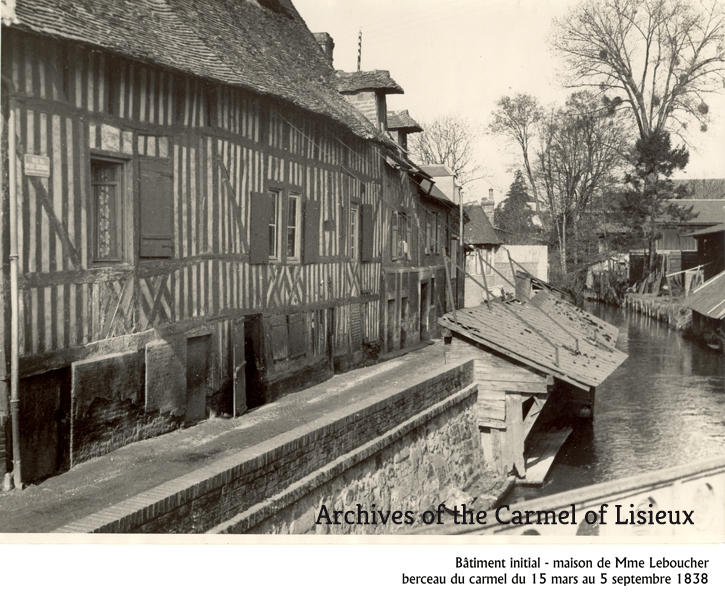 The first lodgings of the Carmelites in Lisieux
The first lodgings of the Carmelites in Lisieux
Although Eugenie was not yet with them, she had told Mme Le Boucher not to say a word to the nuns because Carmelites kept silence at night. Because Eugenie had with her the keys to the room where the nuns were to sleep, Fr. Sauvage could not show them to their bedrooms, so they were obliged to remain with the silent widow. The silence of their hostess disconcerted Fr. Sauvage so much that he soon took his leave. Eugenie eventually arrived, and, since the novices had been up all night, Mother Elisabeth asked Eugenie to show them to the room where they were to sleep. The lock to the room was in poor condition, and it took Eugenie more than 15 minutes to get it open and show them their quarters: a room even poorer than their attic bedroom in Poitiers, with a ceiling so shaky that, if anyone walked in the attic above, pieces of the clay ceiling fell on the beds. The tiny provisional quarters (located on the second floor and attic of the widow’s house) are described in the history of the monastery. The small chapel was properly equipped, and, before the nuns arrived, Father Sauvage offered the first Mass there and reserved the Blessed Sacrament. Eugenie was present.
The formal ecclesiastical establishment of the Carmel of Lisieux
Although the quarters were small, the foundation was established with high hopes and in accord with all the proceedings of the Church. The bishop of Bayeux designated his vicar-general, Rev. Abbot Falize, to receive the Carmelites in his name and to install them in their temporary home. Fr. Falize made a special visit to Lisieux for this purpose, and, in the little chapel, offered Mass, first singing the “Veni Creator.” In the evening Father Sauvage, who had been too exhausted by the all-night journey to be present, returned with the vicar-general, who gave Benediction of the Blessed Sacrament, chanted the Te Deum, and afterward gave an exhortation to the nuns in their small choir. He designated Father Sauvage as their ecclesiastical superior, chaplain, and ordinary confessor. The hearts of all present were full of joy and thanksgiving.
Eugenie, the first postulant, becomes Sister Saint-Joseph of Jesus
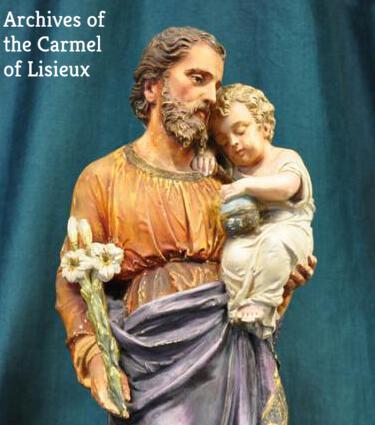 The statue called "St. Joseph of the novitiate"Four days later, on the feast of Saint Joseph, Eugenie Lerecourt, now 29 years old, was received as a postulant, taking the name of Sister Saint-Joseph of Jesus.
The statue called "St. Joseph of the novitiate"Four days later, on the feast of Saint Joseph, Eugenie Lerecourt, now 29 years old, was received as a postulant, taking the name of Sister Saint-Joseph of Jesus. 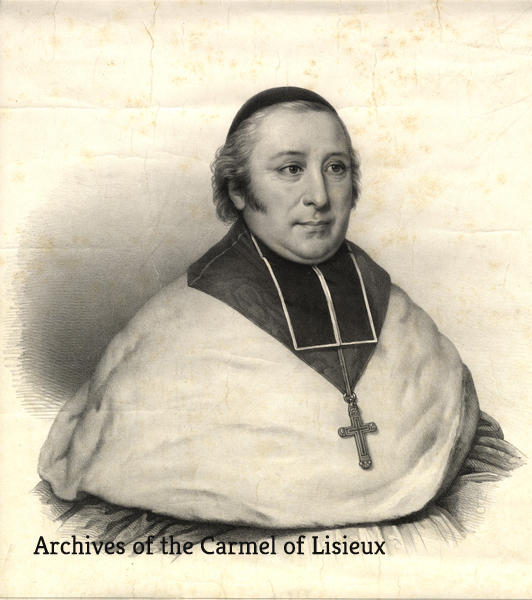 Louis-Francois Robin, bishop of Bayeux from 1836-1855Work on the convent proper continued, and Bishop Robin celebrated the first Mass there on August 24, 1838. The nuns took possession on September 5, 1838. Eleven days later, the three novices formed at Poitiers made their vows. A month after that, on October 16, 1838, Sister Saint-Joseph received the habit of Carmel. On November 20, 1839, she was professed.
Louis-Francois Robin, bishop of Bayeux from 1836-1855Work on the convent proper continued, and Bishop Robin celebrated the first Mass there on August 24, 1838. The nuns took possession on September 5, 1838. Eleven days later, the three novices formed at Poitiers made their vows. A month after that, on October 16, 1838, Sister Saint-Joseph received the habit of Carmel. On November 20, 1839, she was professed.
Her Carmelite life: loving and hidden
Little more is known of her Carmelite life. With a humility which caused a loss to history, Sister Saint-Joseph asked for no “circular” (a brief account of the life and vocation of a nun which accompanied the announcement of her death to other French Carmels) other than a request for the prayers of her Order.
The Chronicle of the monastery says only:
What she was in our beloved monastery, only those who knew her could tell us. Scrupulous but also very obedient, her superiors only had to say, "Go in peace ... I will take care of it." Sister St. Joseph blossomed and we could see her go to Jesus with these simple words.[9]
The Carmelites called her “good, charitable, especially loving for the novices . . . knowing how to do for them small tricks for fun. . . . . The forty-third novice . . . will be called Therese Martin.”[10] 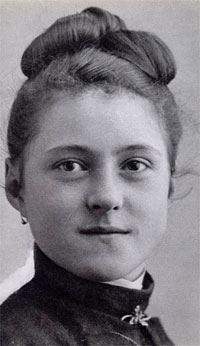 Therese Martin, April 1888, aged 15By the time Therese entered on April 9, 1888, Sister Saint-Joseph, then 79, and Mother Genevieve were the only witnesses of the foundation then living at Lisieux Carmel. (Sister St. John of the Cross had left to staff the Carmel of Saigon and then to refound the Carmel in Caen. Sister Marie of the Cross had died). When Therese entered, Sister Saint-Joseph had been completely deaf for several years. They could only smile at each other!
Therese Martin, April 1888, aged 15By the time Therese entered on April 9, 1888, Sister Saint-Joseph, then 79, and Mother Genevieve were the only witnesses of the foundation then living at Lisieux Carmel. (Sister St. John of the Cross had left to staff the Carmel of Saigon and then to refound the Carmel in Caen. Sister Marie of the Cross had died). When Therese entered, Sister Saint-Joseph had been completely deaf for several years. They could only smile at each other!
Sister Saint-Joseph’s golden jubilee: November 20, 1889
Nineteen months after Therese entered, Sister Saint-Joseph celebrated the 50th jubilee of her Profession. Because of her deafness, she asked to be dispensed from the usual High Mass in the chapel with a special sermon (to which the public would have been invited) and the parlor visit. Her great feast was celebrated in the intimacy of the cloister. The two songs written and sung for the occasion (recreational songs, not hymns) give a glimpse of some highlights of her half century in Carmel.
The community’s song to its jubilarian
The whole community sang to the jubilarian the lyrics Therese’s sister Pauline, Sister Agnes of Jesus, wrote, to the tune of “I Am a Christian.” Sister Agnes teased Father Olivier, Eugenie’s first sponsor, who had been frightened of allowing someone believed to have tuberculosis to embrace the austere life of Carmel. The nuns chanted that she had lived 50 years on the vegetarian diet of Carmel. They recall the solemn and funny adventures of the Foundation, now obviously part of the monastery’s oral tradition: Eugenie’s presence at the first Mass on the vigil of their arrival; her welcoming the nuns at three o’clock in the morning with the tarpaulin-covered cart; telling Madame Le Boucher not to speak to them; leaving them alone with their hostess, without the key to the bedroom, for three hours. One day, probably when escorting the older nuns to the new monastery under construction, she was frightened that they would fall into the muddy ditch (their temporary house was on the banks of the Orbiquet River). The song also recalled that, when, wielding the discipline (cords of a small whip with which the nuns scourged themselves on certain days), Sister Saint-Joseph was so lacking in skill that the discipline went whirring toward the altar, where it was about to be incensed. The song suggests that the young nun's humorous adventures distracted the community so much that she was asked to apply herself more seriously or to leave the Carmel. She became more serious, but one day, alas, in the refectory, she fell while holding the bottles (probably of cider). 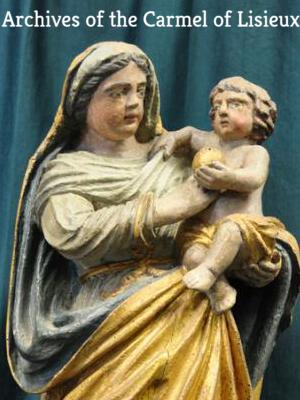 The "Virgin of the Fountain," a reputedly miraculous statue dating from the time of the foundationThe lyrics seem to suggest that Sister Saint-Joseph was especially devoted to a statue known as the "Virgin of the staircase." When the construction of the monastery made it necessary to move the statue, she was so distressed that the prioress promised to find a new niche for it.
The "Virgin of the Fountain," a reputedly miraculous statue dating from the time of the foundationThe lyrics seem to suggest that Sister Saint-Joseph was especially devoted to a statue known as the "Virgin of the staircase." When the construction of the monastery made it necessary to move the statue, she was so distressed that the prioress promised to find a new niche for it.
Evidently one day a man wanted to buy a cap, but she heard him improperly and told him she had no carrots! From then on Sister Saint-Joseph accepted her deafness. This funny song to the deaf “doyenne” of the monastery ends gently:
You hear nothing from the earth
But you have the songs of heaven.
To the little, God is not harsh,
But sweeter than a honeycomb.
Obtain for us the spirit of childhood,
and let us keep it forever.
At the word of obedience,
Ah! may we go in peace.[11]
The nuns remembered how Sister Saint-Joseph would obey when told to go in peace. Perhaps prophetically, they asked her to bless them with the “spirit of childhood” (Pauline’s phrase, “l’esprit d’enfance”), for which their Carmel would become famous. Although the jubilarian could not hear the words of the song, she laughed heartily, knowing that they were celebrating her early mistakes and adventures.
The novices’ loving song to the dean of the monastery
In the evening, the novices usually sang a playful and tender song to the jubilarian. Sister Marie of the Angels, their mistress, composed lyrics to the tune of “Mercy, my God.” 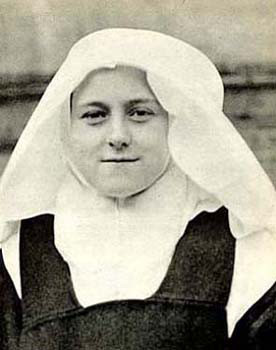 Sister Therese of the Child Jesus, novice, 1889Therese joined in singing of the novices’ love for Sister Saint-Joseph, who was always “good and friendly,” who liked to tease them, but even more to tell them about Jesus. They sang of how she had been the first postulant to join the foundation and had “met the mothers in an elegant car” to take them to the poverty of Bethlehem. They celebrated her virtues, her fervor, her spirit of faith, how humble and loving she was, how her face shone with happiness.
Sister Therese of the Child Jesus, novice, 1889Therese joined in singing of the novices’ love for Sister Saint-Joseph, who was always “good and friendly,” who liked to tease them, but even more to tell them about Jesus. They sang of how she had been the first postulant to join the foundation and had “met the mothers in an elegant car” to take them to the poverty of Bethlehem. They celebrated her virtues, her fervor, her spirit of faith, how humble and loving she was, how her face shone with happiness.
Sister Saint-Joseph returns to God: January 2, 1892
A little more than two years later, Sister Saint-Joseph witnessed the death of Mother Genevieve, her novice mistress and companion in the foundation. She survived the founder by less than a month. Five days after the epidemic reached the Carmel, the oldest woman in the house became its victim. Sister Saint-Joseph of Jesus, the first postulant, returned to God on the morning of January 2, 1892, Therese’s nineteenth birthday. At the age of 82, Sister Saint-Joseph had spent 52 years as a Carmelite of Lisieux. Writing about the epidemic in 1895, at age 22, Therese commented: “My nineteenth birthday was celebrated with a death.” This death was very peaceful. Sister Saint-Joseph, whose father had been a policeman and whose teacher had beaten her, had always feared 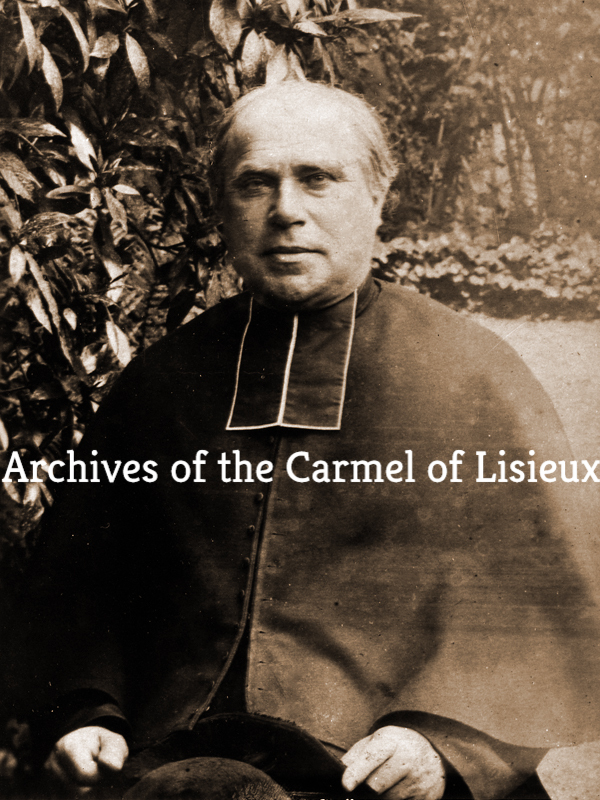 Fr. Louis-Auguste Youf, chaplain to the Carmelites from 1873 until 1897
Fr. Louis-Auguste Youf, chaplain to the Carmelites from 1873 until 1897
the great terrors of death, and they were spared her. “All justice must be fulfilled,” she used to say, but the good God at this supreme moment lavished with consolations this soul so simple and religious. We could hear our dear sister calling Jesus, there was no need to stimulate her acts of love or abandonment. Her death throes were a continual prayer, and it was sweet to be near her, one felt a soul worthy of going to unite with God. Our dedicated chaplain also kept saying to our dear Sister these consoling words: "Go to heaven! ..." And yes, it is the unanimous cry of all of us: "Our good Sister Saint-Joseph went straight to Heaven!”[12]
This was a bold statement for 1892, when many believed that even the most fervent nuns would go first to Purgatory. That same day Pauline, who was also ill, announced the death of Sister Saint-Joseph in a brief note to Celine:
Our poor Mother {Gonzague] is very tired, her face would make you tremble… Pray for her!
This morning, Sr. St. Joseph left to join Mother Geneviève. Tell Uncle and Aunt. We are very upset…[13]
Sister Saint-Joseph’s brief obituary circular; her funeral Mass
Mother Gonzague respected Sister Saint-Joseph’s request that no biography be included in the notice of her death. From her own sickbed the prioress wrote to announce the death of the community’s first postulant, calling Sister Saint-Joseph a
“soul filled with simplicity and innocence, a real old style example of the first daughters of Our Mother Saint Teresa and whose death, like the humble and hidden life, leaves us with great peace and the sweet assurance of her happiness.”[14]
Sister Saint-Joseph’s funeral Mass was set for Tuesday morning, January 5, at the Carmel. The evening before, another nun died (see part 5, to come). On the day of the funeral Celine Martin, who attended (doubtless accompanied by Leonie and the Guerin family), wrote to her cousin, Jeanne La Neele, at Caen:
Dear little Jeanne,
Since you left us on Sunday, I have not much cheerful news to tell you. On the contrary, there is plenty of sad news.
The poor Carmel is right now a prey to the influenza epidemic, the plague is raging there in full force. This morning we were at the burial of the religious who died on Saturday . . . . [15]
One can imagine how Therese loved this kind, friendly Sister who could not understand a word Therese might say, but whose face radiated goodness, and how Therese revered her as a true daughter of St. Teresa who had participated fully in the hardships of the establishment of the Carmel. So humble and so hidden, she was the first to disappear in the pandemic.
The oldest and the youngest sisters in the Lisieux Carmel: Sister Saint-Joseph joins with Therese to obtain a favor for Madame L.
Interestingly, outside the Carmel Sister Saint-Joseph was not forgotten. On April 13, 1983, Madame L. wrote to the Lisieux Carmel that Sister Saint-Joseph had joined with St. Therese to obtain a favor for her family.[16] Madame L. was a native of Eugenie Lerecourt’s birthplace, Saint-Meen-le-Grand. Her son-in-law was unemployed. On the very day she learned that he was to apply to a place where it was very hard to get a job, she read in a magazine published at Lisieux about Sister Saint-Joseph, who had been born in her own home town. Every day Madame L. prayed to Sister Saint-Joseph and to St. Therese, and on March 19, the anniversary of Sister Saint-Joseph’s entering Carmel and the feast day of her patron saint, her son-in-law received a letter asking him to report for an interview, and he was hired. It seems that the oldest and the youngest sisters in Carmel, whose relationship was one of silence on earth, had joined to obtain blessings from God for this family.
Note: I should like especially to acknowledge the generosity of the Carmelite nuns of Lisieux and of the Association of the Friends of St. Therese and of her Carmel, who for many years have invested so much energy in digitizing their treasured archives and making them available to the world. Without this extraordinary gift, it would have been impossible to write anything about Sister Saint-Joseph.
[1] I should like to acknowledge that almost all the information below is drawn from the Web site of the Archives of the Carmel of Lisieux. To learn Sister Saint-Joseph’s full story, please consult the three articles I’ve listed in the separate "references" section of this blog entry. I am also indebted to the Carmel for most of the illustrations.
[2] Like Therese’s mother and father, Eugenie was the daughter of a soldier.
[3] Zelie’s father had also become a policeman when he returned to civilian life.
[4] Biography of Sister Saint-Joseph of Jesus on the Web site of the Archives of the Carmel of Lisieux, paragraph 3, at http://www.archives-carmel-lisieux.fr/english/carmel/index.php/les-bonnes-vieilles/saint-joseph-de-j%C3%A9sus/biographie. Accessed 5/24/2020.
[5] This is the very hospital in which Therese’s father, St. Louis Martin, would be interned in 1889.
[6] Therese’s sister Leonie became a nun of the Visitation of Caen from 1899-1941.
[7] Wikipedia, “Couvent de la Visitation de Caen,” https://fr.wikipedia.org/wiki/Couvent_de_la_Visitation_de_Caen. Accessed 5/24/2020.
[8] That is, the priest who was the “ecclesiastical superior” of the monastery and was accountable to the bishop for its smooth operation. This position is distinct from the role of prioress; the nuns elected their own prioress, known as “Our Mother.” The “ecclesiastical superior” when Therese entered, who was still in office when Sister Saint-Joseph died, was Canon Jean-Baptiste Delatroette; the nuns referred to him as “our Father Superior”).
[9] Biography of Sister Saint-Joseph of Jesus on the Web site of the Archives of the Carmel of Lisieux, http://archives-carmel-lisieux.fr/english/carmel/index.php/les-bonnes-vieilles/saint-joseph-de-j%C3%A9sus/biographie, accessed May 25, 2020.
[10] Ibid.
[11] My translation, from the Web site of the Archives of the Carmel of Lisieux at http://www.archives-carmel-lisieux.fr/carmel/index.php/les-bonnes-vieilles/saint-joseph-de-jesus/biographie, accessed 5/26/2020. Translation copyright Maureen O’Riordan 2020. All rights reserved.
[12] Biography of Sister Saint-Joseph of Jesus, http://www.archives-carmel-lisieux.fr/english/carmel/index.php/les-bonnes-vieilles/saint-joseph-de-j%C3%A9sus/biographie, accessed May 26, 2020.
[13] Letter of Sister Agnes of Jesus to Celine Martin, January 2, 1892, on the Web site of the Archives of the Carmel of Lisieux. http://www.archives-carmel-lisieux.fr/english/carmel/index.php/janvier-1892/3588-de-soeur-agnes-de-jesus-a-celine-2-janvier-1892, accessed May 25, 2020.
[14] The circular of Sister Saint-Joseph of Jesus on the Web site of the Archives of the Carmel of Lisieux. http://archives-carmel-lisieux.fr/english/carmel/index.php/les-bonnes-vieilles/saint-joseph-de-j%C3%A9sus/circulaire-de-sr-st-joseph-de-j%C3%A9sus, accessed May 25, 2020. Note how these lines foreshadow what Therese would later write about her novice mistress, Sister Marie of the Angels: "Our novice mistress was really a saint, the finished product of the first Carmelites." (Story of a Soul, 3rd edition, tr. John Clarke, O.C.D. Washington, D.C.: Washington Province of Discalced Carmelites, 1996, p. 151).
[15] Letter from Celine Martin to Jeanne La Neele, January 5, 1892, on the Web site of the Archives of the Carmel of Lisieux: http://www.archives-carmel lisieux.fr/english/carmel/index.php/janvier-1892/2835-de-celine-a-jeanne-la-neele-5-janvier-1892, accessed May 25, 2020.
[16] Letter from Madame L. to the prioress of the Lisieux Carmel, April 13, 1983, on the Web site of the Archives of the Carmel of Lisieux, http://www.archives-carmel-lisieux.fr/english/carmel/index.php/les-bonnes-vieilles/saint-joseph-de-j%C3%A9sus/document-miracle-de-sr-st-joseph-de-j%C3%A9sus, accessed 5/26/2020.

